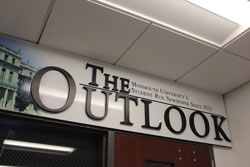Rising tuition costs and spending habits have been points of debate on college campuses, including Monmouth. As students watch their tuition increase every year, questions continue to circulate about how that money is allocated among academics, athletics, and student services. More specifically, whether the price truly reflects the value.
Some editors shared concerns about how Monmouth allocates tuition funding. One editor said, “I think that Monmouth spends a lot of money on athletics and not enough money on student services and academics. At the end of last year, they cut the peer-assisted learning, which took away not only student jobs, but also a student service.”
Others felt the balance wasn’t entirely off but could be improved, with one editor sharing, “Monmouth does an okay job balancing tuition spending, but it could always improve.”
When asked which areas of campus should receive more funding, editors repeatedly pointed to clubs, academics, and student services. One editor said, “Clubs are such a large part of the university, and something we advertise so heavily, yet clubs struggle to do anything with a lack of funding that is being cut year after year.”
Another added, “Tuition keeps increasing, but budgets for clubs keep decreasing, and it makes no sense to me. So many organizations are struggling with funds, and it’s really a shame to see.” Others noted that academic spaces could use attention, pointing out classrooms that could be improved to create a better learning environment.
Nationally, college spending has faced increased scrutiny as tuition continues to climb. According to the College Board, the average published tuition and fees at private nonprofit four-year institutions reached $43,350 for the 2024–25 academic year, marking a continuation of the long upward trend. Many schools have been criticized for prioritizing athletics and administrative spending while cutting budgets for academic and student services, a trend reflected in some of the editor’s concerns.
Editors had different views on whether the tuition costs themselves are justified. One editor expressed frustration with price increases, saying, “The tuition cost is constantly getting worse and worse. There is no reason that the price should’ve been raised every summer since I started going here. If anything, returning students shouldn’t have to see that increase in price since that’s not something we originally agreed to.”
Another editor offered a different perspective, saying, “I mean, it is a private school, so the higher tuition does make sense. I also think the school is fairly good with giving out scholarships, so the tuition is not as daunting for some.”
One editor, however, was more critical of how tuition is used, saying, “I don’t feel as if Monmouth is using my thousands of dollars a year to invest in me as a student, rather invest in my uber athletic peers. I believe Monmouth Athletics should be supported, but I believe there is a disparity between clubs, athletic, and academic funding.”
An editor suggested that the University gather student input via a survey on where they think the money should be allocated.
The conversation about tuition isn’t new, but it remains a pressing issue. As tuition rises, students are questioning whether their investment reflects their academic and campus experience. Whether it’s the growing emphasis on athletics or limited funding for clubs and academics, tuition distribution remains a topic that sparks debate among students and editors alike.

